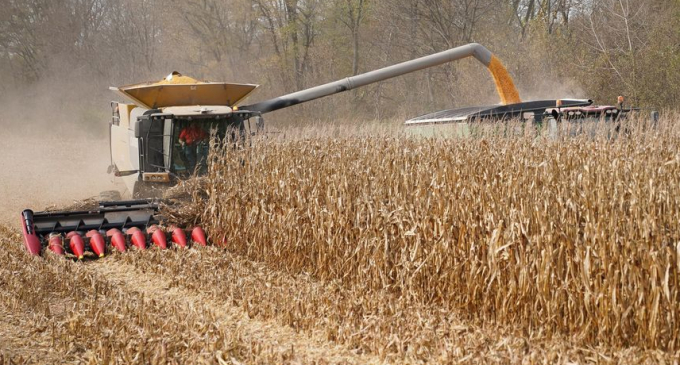June 8, 2025 | 19:52 GMT +7
June 8, 2025 | 19:52 GMT +7
Hotline: 0913.378.918
June 8, 2025 | 19:52 GMT +7
Hotline: 0913.378.918

As the growing season progressed closer to harvest, though, disease issues and other problems started to expose problems for the “garden spot” in the East. Photo: WSJ
Weekly crop condition ratings, a weekly look at the U.S. Drought Monitor and then the Pro Farmer Crop Tour in August all told a similar story: growing conditions have been better in the Eastern Corn Belt versus the Western Corn Belt this year.
As the growing season progressed closer to harvest, though, disease issues and other problems started to expose problems for the “garden spot” in the East, a picture that was painted by crop conditions.
Farm Journal field agronomist Ken Ferrie says tar spot started appearing in August, now says the issues in some fields is unprecedented. He says heavily inflected fields have essentially progress from August 31 to October 31 in a week’s time.
“In a number of fields, not only have the wheels come off the bus, but it's sliding down the highway on its frame and the sparks are flying,” he says.
Just this week, Farm Journal associate field agronomist Missy Bauer echoed Ferrie’s concerns, saying in extreme cases, yields are being cut in half.
“We are hearing a lot of reports of 60 up to even 100 bushel per acre yield hits, where these plants really got killed prematurely from the tar spot.”
While Bauer offered tips to assess fields impacted by tar spot in order to prioritize what fields should be harvested first, it’s an issue not hitting every field in every state. According to Naomi Blohm of Total Farm Marketing by Stewart Peterson, harvest yields are far from consistent this year.
“We are hearing very mixed results for yields, and I can't stress it enough,” says Blohm. “In places where we thought the yields would be fantastic like eastern Iowa, I'm hearing field reports where they were expecting 230 bu. per acre, but it’s coming in at 200.”
She says those mixed results are coming from all across the Corn Belt this year as farmers see real-time harvest results, which will make it hard to peg the total crop production picture this year.
“We’re hearing North Dakota corn yields coming in 150 [bu. per acre] to 175 [bu. per acre], but then over in Indiana, where it had been mostly Garden Spot, we are hearing 230 bu. per acre range. So, it is very mixed all over the place. A lot of it's stemming, of course, and where they had the most heat, the least amount of rains or the most amount of rains the summer. But I think what the biggest thing and the biggest takeaway is that it's going to be a little tricky to see that bigger number that the USDA is suggesting on the USDA reports.”
Bob Utterback of Utterback Marketing says while reports from northern areas of the Corn Belt are being chalked up as disapoiting, he says the opposite is happening in areas father south.
“I think the northern market analysts will be bullish and the central and southern Mark analysts will be bearish, because I have faremrs in southern Ohio and southern Indiana who hav record crops. We have farmers from Arkansas saying it’s the best crops they’ve ever had. And we have farmers from Missouri saying it’s decent. So, I think the good is good, but the bad is not as bad as we thought back here in June and July.”
Utterback says histically, there’s a 50/50 chance USDA will raise the yield between the September and Ocotber Crop Production reports. He thinks this year, the likelihood is more along the lines of 60% to 70%. He also thinks with fewer acres being abandoned this year due to crop production issues, he thinks the acreage picture will see very little change between now and the end of the year.
“I lean to mildly bearish supply factors, but I think a lot of that bearishness has already factored in because remember, we're over $2 off the high in beans and down more than $1.40 from the highs in corn,” adds Utterback. “And historically, percentage wise, tht is probably compatible with when we were at $4 or $4.50 in corn. So, I don't think it’s time to get super bearish. It's time to start considering what do.”
Blohm says as faremrs weigh their options in either selling at harvest, storing or even looking to forward contract in the year ahead, she says the decision will require producers to fine tune spread sheets.
“Think about your cost of production, and what you can lock in for inputs already or not,” she says.
Blohm points out next week’s USDA Quarterly Grain Stocks report could also be a determining factor in the bear vs bull argument.
“There are a lot of factors going into play with that Quarterly Stocks report when you stop and look at how tight basis is and how strong it is right now, it’s not normal this time of year,” adds Blohm. “That makes me think that the Quarterly Grain Stocks report and the old crop ending stocks are still tighter than what USDA is suggesting. We'll get that answer next week on the 30th.”
(agweb.com)

(VAN) With the war ongoing, many Ukrainian farmers and rural farming families face limited access to their land due to mines and lack the financial resources to purchase needed agricultural inputs.

(VAN) Vikas Rambal has quietly built a $5 billion business empire in manufacturing, property and solar, and catapulted onto the Rich List.

(VAN) Available cropland now at less than five percent, according to latest geospatial assessment from FAO and UNOSAT.

(VAN) Alt Carbon has raised $12 million in a seed round as it plans to scale its carbon dioxide removal work in the South Asian nation.

(VAN) Attempts to bring down the price of the Japanese staple have had little effect amid a cost-of-living crisis.

(VAN) Fourth most important food crop in peril as Latin America and Caribbean suffer from slow-onset climate disaster.

(VAN) Shifting market dynamics and the noise around new legislation has propelled Trouw Nutrition’s research around early life nutrition in poultry. Today, it continues to be a key area of research.